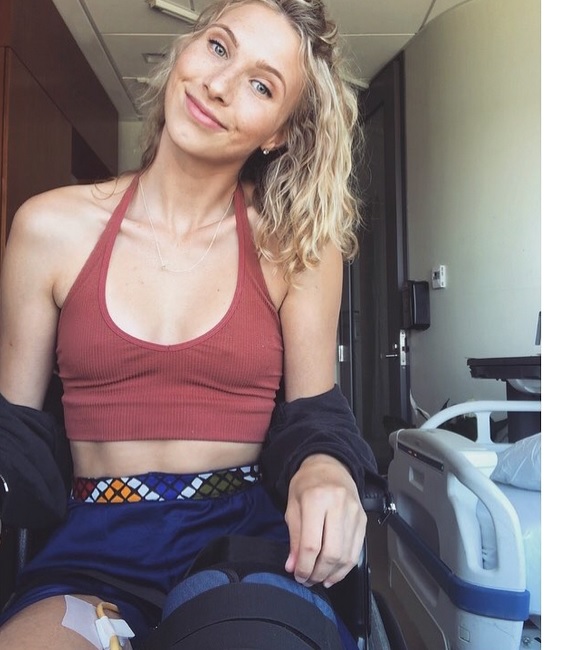
So far, only about 20 people on earth have had AMI surgery, the newfangled amputation procedure pioneered by MIT engineer Hugh Herr and Brigham and Women’s surgeon Matthew Carty. One of those patients, 24-year-old athlete and model Lexie Bader, has gone through it twice—left below-knee in 2019, right below-knee in January of this year. We won’t give you Bader’s whole backstory, but you should read it here. Our chief interest is in her experience with AMI surgery, and whether the procedure’s key benefits (decreased pain, increased control over prosthetics) have borne out.
As you’ll recall from this month’s print issue and the article in our May 5 newsletter, AMI surgery may eventually be used to modify prior amputations. So there’s a lot existing amputees can learn from Bader’s journey. Here are five takeaways.
1. Play It Straight
“I was in a cast for about a month after surgery,” Bader says. “They need to immobilize the knee and allow the soft tissue to heal. Basically they reconnect everything, and the connections they’re making are pretty fragile.”
To refresh your memory, AMI’s core innovation is to preserve the relationships between agonist-antagonist muscle pairings. The surgeon achieves this by reattaching connective tissue that is severed during limb removal. While those connections heal up, it’s necessary to immobilize the joint nearest the limb terminus—the knee, in the case of a below-knee patient like Bader. Hence the addition of a cast to the typical post-operative dressings.
“I couldn’t bend my knee for about a month,” Bader says. “The cast went all the way up to my hip.” As soon as she got the green light to remove the cast, she was back in the gym a few days day later.
2. Slay the Phantom
Both of Bader’s amputations were necessitated by complex regional pain syndrome (CRPS), so she’s all too familiar with neural unpleasantness. AMI has been a big success in that regard: She no longer requires medication to control her pain, and she’s had only mild phantom limb pain in the wake of both AMI procedures.
“I barely get phantom pain anymore,” Bader says. “Maybe once a week I’ll get a sharp pain on the arch of my left foot, but it goes away after 30 seconds or so, and then it’s gone for a week or a month. The right side is a little more sensitive. Sometimes when I sleep, it hits on a certain nerve and I get a bruising feeling in my ankle.”
The bigger complaint at the moment is itching. “Pain—whatever, it’s pain,” she laughs. “But itching? Oh my god, I hate that. Both of my ankles itch from time to time, and I’ll be shaking my leg, trying to scratch. It can drive you nuts.”
3. Space Out
AMI is meant to give amputees a stronger sense or proprioception (or ability to locate their phantom limb in space) than individuals with conventional amputations. Bader can’t say for sure whether she has heightened powers in this regard—she doesn’t have any way to compare her subjective experience to anyone else’s. But she does say her intuitive awareness of her limbs’ positions is largely intact.
“I can point my toe, which is weird,” she says. “I can rotate my ankle, I can scrunch up my foot, I can raise it or lower it. If I stand on one foot, I still have to wiggle my other foot around in the air to redistribute my weight and keep my balance.” All those sensations suggest that the residual muscles are communicating as intended with each other—and, more to the point, with the nervous system. “It means the limb is still sending feedback to my brain,” Bader says. “My brain is perceiving my foot as if it’s still there, and it’s helping me keep my balance.”
4. Muscle Up
To get the maximum benefit out of AMI surgery, it’s essential to keep the residual limb toned. The surgical team gave Bader exercises specifically tailored to that purpose, to go along with the standard rehab workout.
“You put a band around the end of your limb,” she explains, “and then you pull on it and move your foot up and down. That helps the leg muscles heal and get bigger and stronger. It’s a very specific exercise. They also want me to strengthen my hips and glutes, because that helps a lot with your gait.” The overriding goal, Bader says, is to keep the leg muscles from atrophying as much as they would with a regular amputation, “because those are what you need to activate the bionic limb.”
5. Eyes on the Prize
The ultimate goal of AMI surgery is to give you enhanced control over a bionic prosthesis. COVID prevented Bader from getting much opportunity to experiment with that part of the process last year, and this year’s second surgery slowed her timeline even further. However, she’s had limited trials with a bionic device on her left leg, and the early reports are encouraging.
“Going up or down steps, squatting, lunging, and even just walking are a lot easier,” she says. “The ankle bends like a normal foot. I can feel my foot moving up and down when I’m walking on stairs.” When she eventually does get to use bionic feet, here’s what Bader is most looking forward to: “When I step on my boyfriend’s toes [in conventional prosthetic legs], I can’t feel it. But I’m pretty sure I’ll be able to feel his feet before I step on them and put all my weight on it.”